Season of the Switch
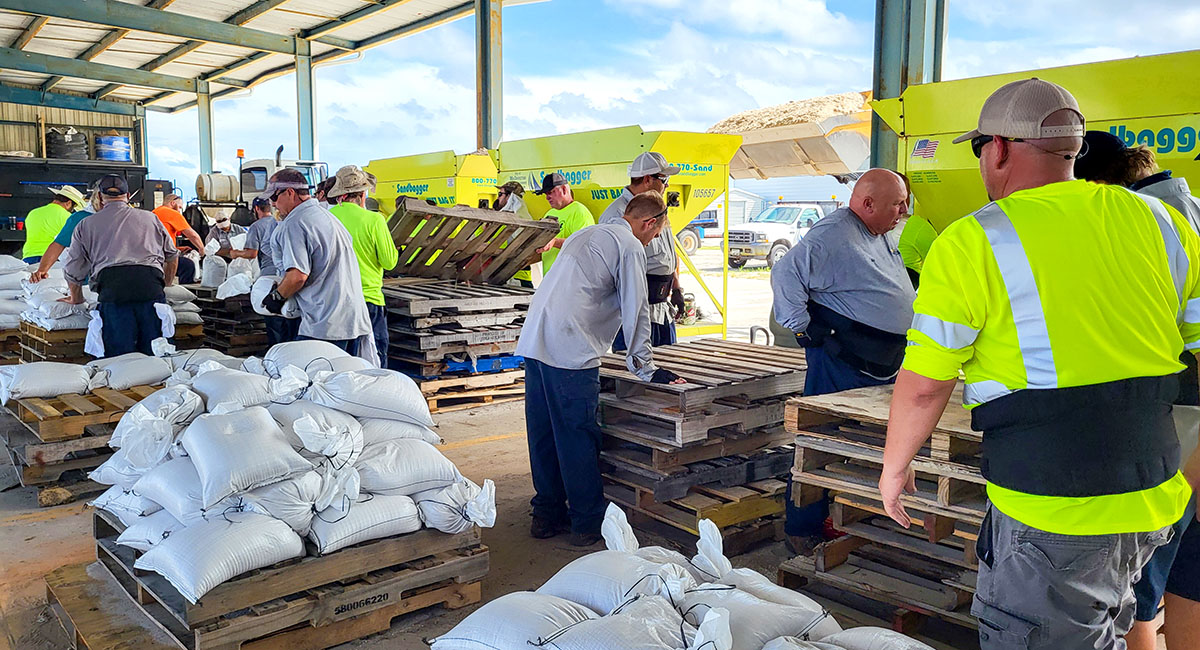
Melbourne city workers help to fill and stack sandbags when a hurricane threatens to flood the streets. CITY OF MELBOURNE
New weather patterns may cause record hurricanes
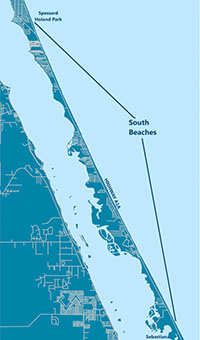
A map showing the area particularly likely to be damaged by a severe storm.
With the forecast for a very active hurricane season worrying residents, emergency managers in Brevard County are offering advice to help everyone stay calm — but ready. Early preparations go a long way toward ensuring the safety of families, pets and homes.
“The most important thing is to make sure you’re prepared, because you’re not stopping the storm,” says Cheryl Mall, spokeswoman for the city of Melbourne. “When a hurricane or tropical storm is coming our way, take it very, very seriously. I can’t emphasize that enough.”
Know what you’re dealing with, she says. Weather patterns this year have shifted, and waters are warmer than usual, making it possible for 11 or more hurricanes to form. At least five are expected to turn into major storms, with winds of 111 mph or higher, according to ongoing tropical research at Colorado State University. Wonder what that kind of wind speed feels like? Stick your arm out the car window, next time you’re driving 55 mph. Now, imagine doubling that. The next forecast comes out on June 11, followed by one on July 9, and one on Aug. 6.
There were seven hurricanes last year, with three considered major — a very average year. In contrast, 2024 is predicted to be the most active season since 2020. Traditionally the second half of the summer, starting Aug. 1, is when hurricanes are most likely to slam into the Atlantic coast — and that’s what’s predicted, this year. But the storms are capricious and that isn’t always true. Atlantic hurricanes are also blowing up closer to the U.S. coastline, in recent years. That leaves less time for last-minute gathering of supplies and deciding whether to evacuate, Mall says.
Hurricane Ian, which destroyed Sanibel Island on the Gulf Coast in September 2022, was still on a lot of people’s minds last year. The Category 4 storm with a 13-foot storm surge killed 161 people, many of whom refused orders to evacuate and died as a result. The sobering reality put an end to much of the boasting and bragging about staying home to have boozy hurricane parties.
Being well informed about hurricanes and tropical storms is a good thing, Space Coast emergency managers say, because it leads to good decisions about safety. But there is a lot to learn. Fortunately, Brevard County has plenty of information designed to make it easy for newcomers and old hands, alike.
EARLY AND OFTEN
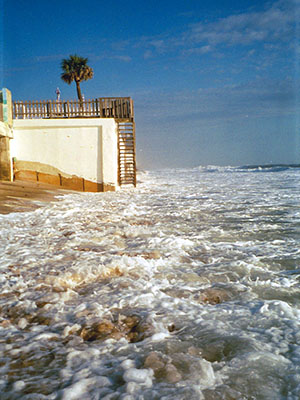
Seawater pounds a Brevard County beach. BREVARD COUNTY PHOTOS
Residents and businesses are advised to begin their planning early, in order to have time to buy and install hurricane shutters and/or protective metal panels, special screening for pool areas, hurricane-proof doors, and impact glass windows. Anyone who wants a generator must figure out what they need for their particular home or business, then learn to operate it safely. For example, a generator must be 20 feet from the house and garage to prevent deadly carbon monoxide poisoning. Ordering and installing a whole-house generator is another option. Keep in mind, thousands of residents and businesses will be competing to get these tasks done. Plan accordingly — and in advance.
Months ahead of the season, pick up a solar-powered or hand-crank weather radio and solar-powered phone charger. Multiple chargers that can be charged ahead of a storm, a solar-powered flashlight, and several solar-powered lanterns can make a huge difference in your comfort level during and after a storm. Heavy-duty coolers, and dry ice if you can get it before the storm, can save some of your food but watch out for spoilage. Keep non-perishable food, dried dinners and gallons of water on hand. Consider buying some tools that will help you clean up the mess on your property afterward.
Older people who can’t bring in outdoor furniture, trim vegetation or install storm panels should arrange, in writing far in advance, for a handyman’s help. People with elderly neighbors should check on them.
Staying home for one of the big hurricanes or tropical storms means being ready to live without electricity and air conditioning for several days or even weeks. It means being prepared for flooding — of houses, businesses, streets and yards. It means being unable to drive, due to flooding and debris. People living near beaches must learn about storm surges and their destructive power, including dumping entire homes into the ocean and destroying high-rise condominiums.
Planning ahead for evacuation means filling the gas tank a week ahead and leaving a day or two early to avoid packed bridges and roads. It also means planning several different routes, depending on which way the storm is expected to go after landing. Pick out some places to stay. Make reservations days ahead of time, and rent storage units to keep your belongings safe, early in the season. There won’t be any left in the height of the season. If you need a safe deposit box at a bank, find one before the season and put your valuables in it then.
Rehearse packing your car, to see how much fits in it. That includes your pets, if you don’t have advance reservations for kennel space. Never leave a pet at home where it could be crushed or drowned. Learn where the pet friendly shelter is, where all shelters are located, and their rules for what you can and can’t bring.

Wild waves leaving a cliff behind on this Brevard County beach. The same beach is shown on the right after restoration. BREVARD COUNTY PHOTOS
STAY IN TOUCH
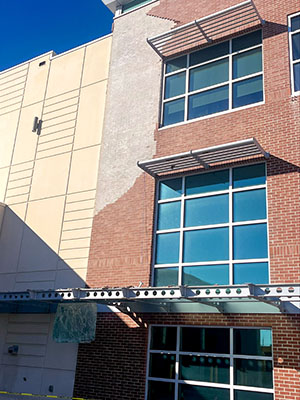
The brick facing was torn off the city of Cocoa’s fire department outer wall and a glass overhang was broken. CITY OF COCOA BEACH
Family and friends will want to know where you are. Make plans for notifying them and keeping them posted before, during and after the storm. When you are out of state, you may find very little news about storm recovery so make plans to learn when it is safe to come home. It could take a while — roads could be covered with debris and power lines on the ground.
What about after the storm? “After a hurricane has impacted our area, it’s important to wait for the winds to pass before leaving your home or shelter,” Horst says. “It can be tempting to get out early and drive around to see the storm’s effects, but we urge our residents and visitors to stay off the roads unless absolutely necessary. Downed trees, limbs, traffic signals, and power lines, as well as flooding, can pose significant dangers to our community.”
After the storm, expect to see beachside roads caved in, sand cliffs with buildings hanging over the edge, damaged or sunken boats, roofs with holes in them, siding torn off and some buildings flattened. Checking for damage after a recent storm in Cocoa Beach, responders found that “the front of the fire department building came off and broke a glass awning over the door,” says Karin Grooms, spokeswoman for Cocoa Beach.
It may be a long time before life is back to normal, but learning all you can about preparing, what to expect, and about how you can help yourself and others after the storm will make the adjustment easier.
“One of the most important ways to be prepared is to have multiple ways to receive emergency notifications,” says Rachel Horst, spokeswoman for Brevard County. “Sign up for countywide text notifications by texting the word BREVARDEOC to the number 888777, and make sure to sign up for location-based AlertBrevard notifications at www.EMBrevard.com.”
EMBrevard.com makes five points: Know your risks and the potential hazards; build a supply kit for during and after the storm; decide what to do; stay informed; and get involved.
“Our goal is to build a culture of preparedness in Brevard County,” Horst says.
RESOURCES & INFORMATION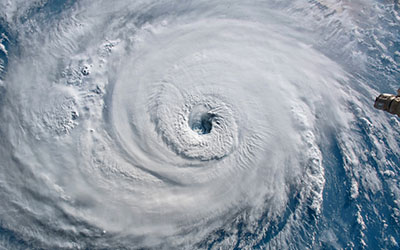
• Learn what to do in Brevard County in the event of a powerful tropical storm or a hurricane: tinyurl.com/ReadyForStorm
• Follow the storms on the National Hurricane Center website. Learn all the details on how to use the site so you can track the path, the wind, and the times of arrival. nhc.noaa.gov
• Navigate the Colorado State University tropical research website to find current and past forecasts, chances of a storm having an impact on Brevard County this year and lots more. tropical.colostate.edu/forecasting.html

Susan Burgess
A Treasure Coast resident since the early 1980s, Susan has worked for the Jensen Beach Mirror and The News Tribune. A bicycling enthusiast, she thinks nothing of riding 20 or 30 miles. A graduate of Columbia University and New York University, Susan is a big fan of eagles.



